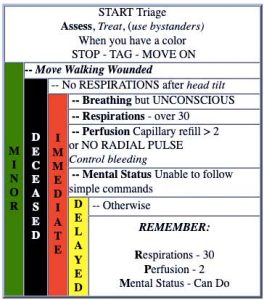Triage is the assignment of degrees of urgency to wounds or illnesses to decide the order of treatment of a large number of patients or casualties. The implication here is you are faced with a LOT of casualties and to save lives, you may need to move quickly to tag each victim as being immediate, delayed, minor or deceased.
For Placentia CERT trained individuals, remember the following:
30 – 2 – Can Do. “Thirty, two, can do”
This means:
- 30 or over respiration’s (see chart below).
- Press a fingernail so the skin under neath looses color and then release pressing the fingernail and count how quickly the natural skin color comes back under the nail. The ideal time is 2 seconds or less. This is the perfusion test.
- Talk to the victim and determine, by their response to the questions you ask, what extent they have good mental status. This is the “can do” test.

Opinion: Websites and apps for diagnosis or triage aren’t very good
